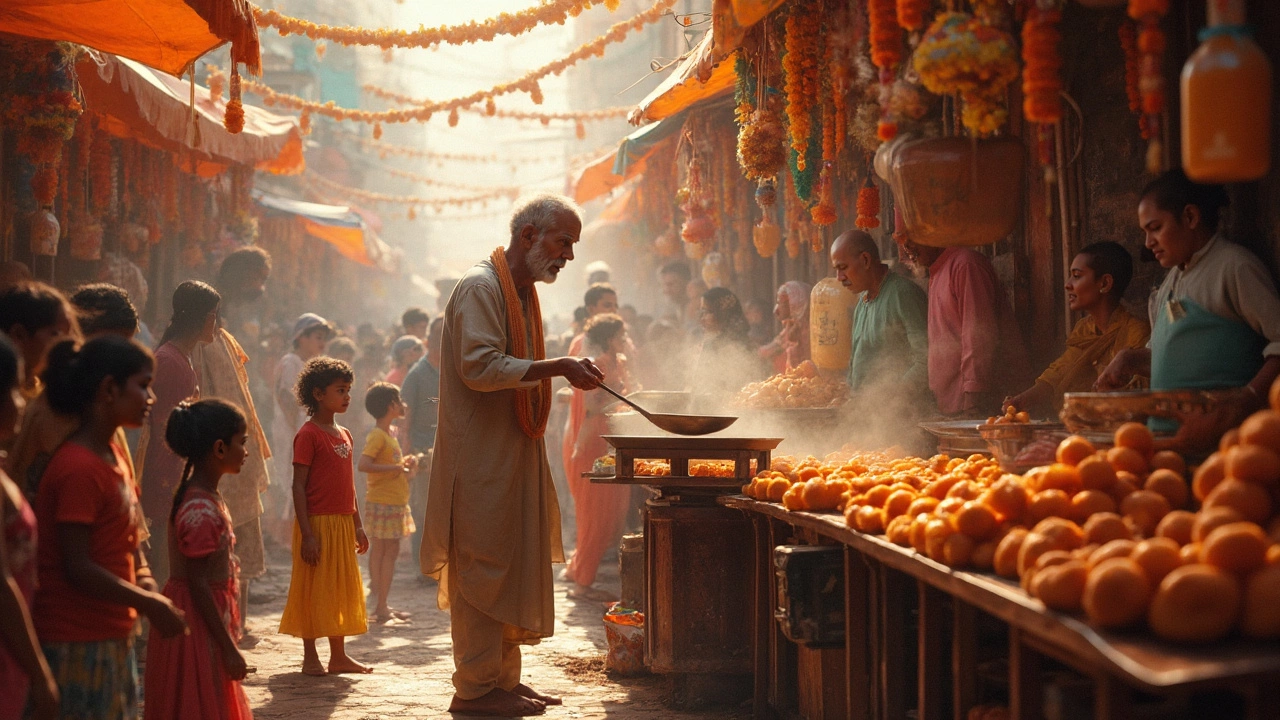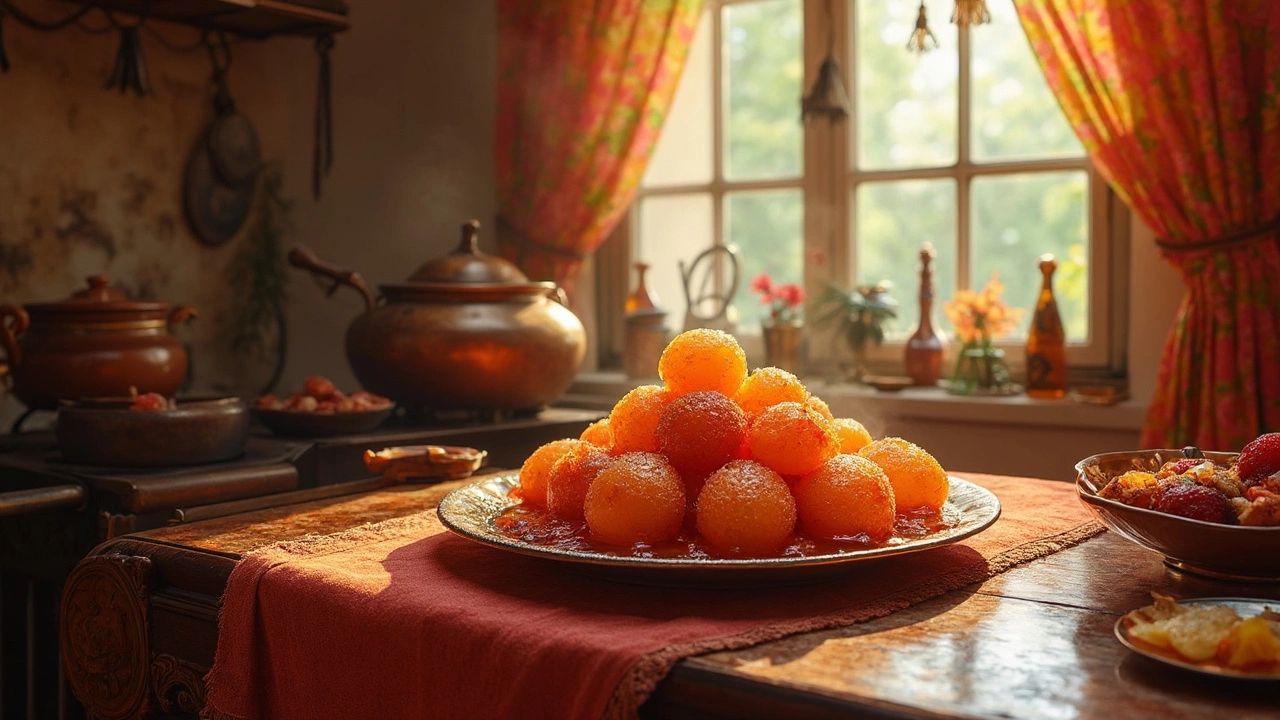13 Feb 2025
- 0 Comments
Ever wondered what the most beloved sweet in India is? Look no further than gulab jamun! This sugary sensation has become the undisputed champion of Indian desserts, delighting both locals and those far beyond with its gooey goodness.
Why is gulab jamun so adored? First, let’s talk simplicity. These little balls of sweetness are made from milk solids, also known as khoya, which are then fried and soaked in syrup. Sounds easy, right? Well, the trick is in the details. You’ve got to get that syrup just right, making sure it's infused with cardamom and a hint of rosewater. And those little golden balls? They should be fried to a perfect consistency—light yet decadent.
But there's more to gulab jamun than just taste. This humble sweet has deep roots in Indian history and culture, dating back centuries and evolving from ancient recipes. From traditional wedding feasts to modest festival celebrations, gulab jamun holds its place on every sweet platter. It’s the go-to for both special occasions and everyday indulgence.
- The Reigning Champion: Gulab Jamun
- Sweet History: Origins and Evolution
- Mastering the Perfect Gulab Jamun
- Beyond Gulab Jamun: Other Popular Sweets
The Reigning Champion: Gulab Jamun
Calling all sweet tooth enthusiasts! Let’s dive deeper into the delicious world of gulab jamun, India’s undisputed favorite. It's more than just a sweet. It's an experience, an emblem of joy in Indian culture, and the star of every dessert table.
The origins of this treat are quite fascinating. It's widely believed that gulab jamun traces back to ancient Persia, finding its way to Indian kitchens during the Mughal era. Originally called 'luqmat al-qadi' in Persian, it charmed its way into the hearts of Indians and was adapted with local ingredients, creating the version so many love today.
The Irresistible Taste
What sets gulab jamun apart? Its unique taste profile! With its sweet, syrupy goodness, each bite tends to melt in your mouth. The aroma of cardamom and the subtle hint of rosewater enhance the flavor, making it a fascinating blend of fragrant and sweet. It's no wonder that this dessert tops the list when we talk about popular Indian sweets.
Ingredients Breakdown
The beauty of gulab jamun lies in its simplicity. Here’s what you typically need to create this masterpiece:
- Khoya or Milk Powder: The base that gives it a rich texture.
- All-purpose flour: Adds structure to the dough.
- Cardamom powder: For that signature aromatic twist.
- Sugar: Used in abundance to make the syrup.
- Ghee: To fry the dough balls to golden perfection.
- Rosewater: Adds a floral touch to the syrup.
Perfecting the Craft
Achieving the ultimate gulab jamun requires finesse. Here are some pro tips:
- Always keep the syrup warm, not boiling, so it lovingly absorbs into the fried balls.
- Fry on low heat. This ensures the gulab jamuns are thoroughly cooked and perfectly golden.
- Let them soak in the syrup for a few hours to achieve that irresistible juiciness.
Making gulab jamun at home can be a rewarding experience. It’s like having a piece of Indian tradition right on your plate. So, ready to impress your friends and family with this delicious treat?
Sweet History: Origins and Evolution
Gulab jamun has a rich tapestry of history woven into its sweet syrup. Its roots go back centuries, believed to have originated in medieval India around the time of the Mughal Empire. In fact, it's often said that it was an invention spurred by the fusion of Persian and Indian culinary traditions.
Origin of the Name
The name 'gulab jamun' is quite fascinating. 'Gulab' means 'rose' in Persian, referring to the rose-flavored syrup, while 'jamun' is a Hindi word used for a South Asian fruit that resembles the shape and size of this delicious sweet. Together, the name is both a nod to its ingredients and its appearance.
Evolution Through Time
Back in the day, gulab jamun was a luxury dessert reserved for royalty and was often on the menu at lavish feasts. Its journey from royal palaces to the common household was gradual but inevitable as its irresistible flavor became beloved across different regions. Today, variations are found in almost every state of India, each adding its own twist, like using saffron, coconut, or even pistachio for a unique taste.
According to culinary historian Dr. K. T. Achaya, "The dessert's ability to bring a touch of royal delight to even humble gatherings is what has ensured its lasting legacy in Indian cuisine."
Modern-day Fame
Despite its long history, the essence of Indian sweets recipes is perfectly captured by gulab jamun's flawless marrying of flavors over centuries. Its preparation may have evolved, embracing modern conveniences like pre-packaged mixes, yet when homemade, it transports eaters back through time with each bite.

Mastering the Perfect Gulab Jamun
If you’ve ever tasted gulab jamun, you know it’s more than just a dessert—it's an experience. Whether you’re a beginner or an expert, nailing the gulab jamun texture and taste requires a bit of finesse. Let’s break it down to make sure your homemade gulab jamun rivals any sweet shop in India.
The Ingredients Matter
Your ingredients are key here. You'll need khoya or mawa for the dough. Some people use milk powder as an alternative, which is fine but slightly alters the texture. You’ll also need flour, baking powder, sugar, water, and a splash of rose water or cardamom for that extra zing in the syrup.
Step-by-Step Preparation
Here's how you can create these delightful treats at home:
- Prepare the Dough: Start by kneading your khoya with a little flour and baking powder until it's smooth and soft. It shouldn’t be too sticky or too dry.
- Shape the Balls: Once your dough is ready, shape it into small, even balls. Ensure they’re smooth, or they might crack while frying.
- Heat the Oil: Heat oil in a pan on medium flame. Fry the balls gently, stirring regularly so they brown evenly. You'll know they’re ready when they turn a rich golden brown color.
- Make the Syrup: While the balls are frying, prepare your syrup. Dissolve sugar in water and bring it to a boil. Stir in cardamom powder and rosewater. Let it simmer until slightly sticky.
- Soak the Balls: Remove the fried balls and drain excess oil. Let them cool slightly before submerging them into the warm sugar syrup. Allow them to soak for at least a couple of hours for the best flavor.
Pro Tips
Want your India sweet to stand out? Here are some tips:
- Always use fresh khoya for the best texture.
- If using milk powder, mix it with milk to make a dough-like paste.
- Balance the sugar syrup—too sweet can be overwhelming.
- Soak the balls until they absorb the syrup entirely. Patience is key!
Once you get the hang of it, you’ll wonder why you haven't been making Indian dessert your whole life. So go ahead, give it a whirl, and enjoy the magic of homemade gulab jamun!
Beyond Gulab Jamun: Other Popular Sweets
While gulab jamun steals a lot of the spotlight, India's dessert scene is packed with other irresistible treats. From the northern regions to the tropical south, there's something to tickle every sweet tooth.
Jalebi
This coiled wonder is a crispy, syrupy delight. Made with a simple batter of flour, fermented overnight, and then deep-fried, jalebi is like a sugary spiral that you can't resist. It's often served with milk or rabri (thickened milk) for a heavenly contrast of textures.
Rasgulla
Originating in the eastern states of West Bengal and Odisha, rasgulla is soft and spongey, soaking up a sugary syrup to create a melt-in-your-mouth experience. Made from freshly curdled chhena (cottage cheese), it's a favorite during festivals and celebrations.
Ladoo
Ladoos are versatile and come in various forms, from besan ladoo made with gram flour to coconut ladoo. They're typically round, sweet, and satisfyingly dense, ideal for munching during pretty much any occasion.
- Besan Ladoo: Nutty, sweet, and made from gram flour, ghee, and sugar.
- Coconut Ladoo: With the tropical goodness of coconut, this one’s often seen during Diwali and other celebrations.
- Motichoor Ladoo: Tiny gram flour balls bound together with sweetness, often spotted at weddings and pujas.
Kaju Katli
If you're a fan of cashews, kaju katli is your go-to. Thin, diamond-shaped slices made from cashew nuts, it's creamy and rich—perfect for gifting during festivals.
India's desserts celebrate a wide array of flavors and textures, making sure there's always a sweet solution for everyone. Next time you’re at an Indian sweet shop, give these a swirl and discover what makes each one special!
